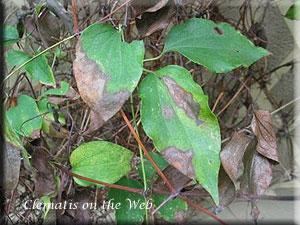10 Flowering Vines to Grow in Virginia
When it comes to sprucing up your garden, there are several flowering vine species native to the Virginia area. Why add a flowering vine to your garden? Flowering vines will not only add a layer of interest to your already existing garden but also attract many pollinators like hummingbirds, bees, and butterflies. Pollinators will help your garden reach its full potential, and your outdoor space will feel like a wildlife sanctuary. Another great reason to add flowering vines is that many flowering vines species are perennials, so the beautiful vines will continue to return for years to come.
Here is a list of the best flowering vine species to grow in Virginia:
Crossvine
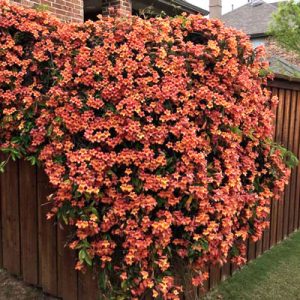
Begonia Capreolata, commonly known as Cross-vine, is a semievergreen vine best known for its ability to cling to wood, stone, and brick without support. This plant is native to Virginia and can commonly be found along roadsides and in forests.
This species of flowering vine grows quite large, reaching a mature height of 30 to 45 feet with a spread of 6 to 9 feet. The Cross-vine is a great choice for those who have a large area of trellis, wood, stone, or brick wall they’d like to cover. The blooms of the Cross-vine are orange on the outside with a yellow throat. On rare occasions, the outside of the blooms may be yellow or deep orange-red in color.
Cross-vines thrive in US hardiness zones 5 through 9. This plant requires average, well-drained soil and full sun to partial shade (around 4 to 6 hours of direct sunlight per day). Cross-vine can tolerate shade, droughts, and brief flooding. The plant is rarely damaged by native deer populations and attracts pollinators such as hummingbirds and butterflies.
Virgin’s-bower
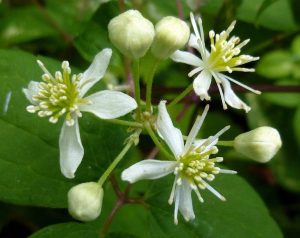
Clematis Virginiana, known by its common name Virgin’s-bower is another flowering vine native to Virginia. This native vine quickly climbs by twining and trailing along the ground. In Virginia, this flowering vine is commonly found in the mountains.
Virgin’s-bower can reach a full size of 6 to 20 feet in height and 3 to 12 feet wide at full maturity. This flowering vine may be better suited for those with less vertical space as it is smaller than some of the other flowering vines on this list. The blooms on this deciduous to semievergreen vine are white in color and bloom from summer to late fall. Virgin’s-bower does spread quickly through self-seeding and root suckers.
Virgin’s-bower requires average, well-drained soil and partial shade. This flowering vine does best in US hardiness zones 3 through 8. The flowering vine can tolerate full sun, shade, and black walnut. Virgin’s-bower is also seldom disturbed by deer but does attract bees, wasps, moths, and birds. It is also important to note some parts of the plant are poisonous and may cause skin irritation.
Yellow Jessamine

Gelsemium Sempervirens, referred to as Carolina Jessamine or Yellow Jessamine, is native to Southern and Central Virgnia. The plant is known for its fragrant yellow bell-shaped blooms, which signal the arrival of springtime.
This plant reaches a mature size of 10 to 20 feet in height and has a full spread of 3 to 6 feet. The Yellow Jessamine is an evergreen vine that climbs through means of twining. The plant is also known for its leaves which take on a bronzy patina in the winter months.
Yellow Jessamine thrives in US hardiness zones 7 through 10. The flowering vine requires humus-rich, well-drained soil and full sun to partial shade (4 to 6 hours of direct sunlight per day). The Yellow Jessamine can tolerate some drought, clay soil, and wind and is rarely disturbed by deer. The highly fragrant yellow blooms begin appearing in December and later rebloom in early fall, attracting bees, butterflies, and hummingbirds. This large, luscious flowering vine also provides cover and is home to many species of Virginia birds.
Coral Honeysuckle
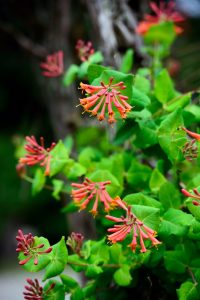
Lonicera Sempervirens, most commonly known as Trumpet or Coral Honeysuckle, is a low-maintenance yet showy vine. In Virginia, this plant can typically be found in Coastal Plain and Piedmont and is infrequently located in the mountains. Coral Honeysuckle is not native to Northern Virginia, except for Fairfax County.
Upon reaching full size, the Coral Honeysuckle will be between 8 to 20 feet high and 6 to 12 feet wide. Similar to the other flowering vines on this list, Coral Honeysuckle is a semi-evergreen vine that spreads and climbs by twining. The plant produces coral to red blooms and red berry-like fruit from the months of August to March.
Coral Honeysuckle does best in US hardiness zones 4 through 9. This plant requires loamy, well-drained soil and full sun to partial shade (4 to 6 hours of direct sunlight a day). Coral Honeysuckle can tolerate clay soil and black walnut. While there are no serious pests or diseases associated with this plant, the plant can develop powdery mildew if the air circulation is poor. Deer do occasionally enjoy the stems and foliage of the plant. The coral blooms that grow from April to June attract butterflies, bees, hummingbirds, and moths.
Virginia Creeper
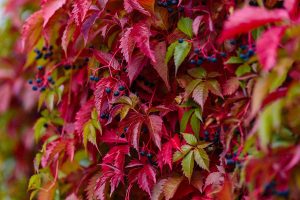
Parthenocissus Quinquefolia, known as Virginia Creeper, is native to the state and is one of the most widely distributed vines throughout Virginia. The plant is known to be a vigorous spreader but does well in environments where other plants do not.
While Virginia Creeper can be grown as a vertical flowering vine, it is a natural ground cover plant. At full maturity, the plant reaches 1 foot in height (as ground cover) and has a spread of 25 to 60 feet. This is certainly something to consider before planting Virginia Creeper in your garden, especially if you don’t have a lot of garden space.
The Virginia Creeper thrives in US hardiness zones 3 through 8. This plant requires average, well-drained soil and full sun to full shade. Virginia Creeper is tolerant of clay, loam, dry and rocky soil, sand, heat, drought, flooding, and salt. However, the plant is occasionally severely damaged by native deer populations. The bluish-black berries of the Virginia Creeper attract various wildlife, primarily birds.
Maypop
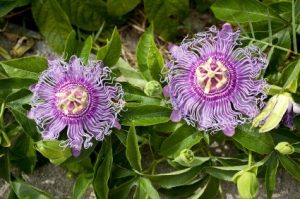
Passiflora Incarnata, best known as Purple Passionflower or Maypop, is a tendril-climbing deciduous vine naturally found in open woods, along roadsides, and in pastures. The Maypop produces exotic-looking flowers and edible fruit, making it a great ornamental plant for a garden.
The flowering vine reaches a height of 6 to 8 feet and a width of 3 to 6 feet. Maypop flowers primarily bloom as a lavender color but rarely will bloom white. The flowers of this plant bloom from May to October. The edible fruit produced by the plant is called Maypops and are pulpy egg-shaped fruit. These yellow-green Maypops are ready for harvest from mid-summer into fall.
Maypop plants do best in US hardiness zones 5 through 9. This plant requires average, well-drained soil and full sun. Maypops tolerate clay soil and drought. The flowering vine also has mild deer resistance. While the beautiful lavender flowers attract bees and butterflies, the young tendrils are a tasty snack for turkeys.
American Wisteria

Wisteria Frutescens, known as the American Wisteria, is a climbing vine native to wet forests and stream banks. The American Wisteria is also known for its rich colored and highly fragrant flowers.
At full maturity, the American Wisteria vine reaches a height of 15 to 30 feet and has a spread of 4 to 8 feet. The flowers produced by the American Wisteria are lavender and light violet-blue in color. This plant’s flowers bloom during the months of April to August, with flowers at the raceme base blooming first.
American Wisteria thrives in US hardiness zones 5 through 9. This plant requires slightly acidic, humus-rich soil and full sun to partial shade ( 4 to 6 hours of direct sunlight a day). The American Wisteria vine tolerates drought and seasonal flooding and is rarely damaged by deer. However, this plant does not do well with being transplanted. Like most fragrant flowers, the flowers of the American Wisteria attract pollinators such as butterflies and hummingbirds.
Trumpet Vine
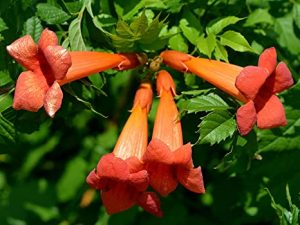
Campsis Radicans, known as the Trumpet Vine, is a self-clinging climber. The flowering vine climbs over almost everything in its path through the use of aerial rootlets. It is important to note these aerial rootlets can damage wood, stone, and brick. However, Trumpet Vine is very useful in the prevention of soil erosion. If you are considering planting Trumpet Vine, it will need to be kept under control as it is an aggressive spreader.
This plant can reach a height of 20 to 40 feet and a width of 5 to 10 feet. Trumpet Vine is a hardy, easy-to-grow plant thanks to its aggressive spreading abilities. Trumpet Vine is an excellent choice for those looking for a plant for walls, trellises, arbors, and fences.
Trumpet Vine does best in US hardiness zones 5 through 9. The plant requires lean to average, well-drained soil and full to partial sun. Trumpet Vine is tolerant of heat, cold, and drought. In the early to late summer, beautiful orange and red flowers sprout from the plant attracting hummingbirds. The flowers then leave behind bean-like seedpods.
American Bittersweet
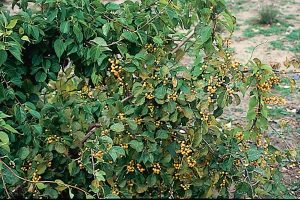
Celastrus Scandens, known as the American Bittersweet, is a fast-growing, twining, woody vine. The vine is well known for its showy bicolored fruit. This plant is native to Virginia and is welcomed in many gardens thanks to its ornamental fruits.
At full maturity, the plant can reach between 15 to 20 feet in height and 3 to 6 feet in width. American Bittersweet is a great plant to use for arbors, ground cover, pergolas, trellises, and fences. The berries of the American Bittersweet bloom in early to late summer. However, the fruit is toxic to dogs, cats, and horses. The berries also have low toxicity to humans if consumed.
The American Bittersweet thrives in US hardiness zones 3 through 8. The plant requires average, well-drained soil and full sun. American Bittersweet is tolerant of drought, dry soil, and deer. Although the American Bittersweet’s berries are toxic to some animals, the plant attracts many species of birds.
Atlantic Pigeon Wings
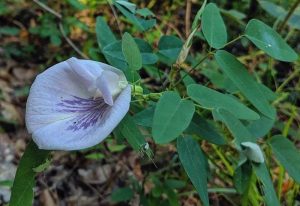
The Clitoria Mariana, more commonly referred to as Atlantic Pigeon Wings, is a flowering vine native to Virginia and much of the United States. This perennial vine is small compared to the other flowering vines included on this list. This makes the Atlantic Pigeon Wing vine perfect for those who do not have a wealth of garden space. While the Atlantic Pigeon Wing plant is commonly used as a ground cover plant, it does have vertical capabilities, making it a great option for arbors, trellises, and pergolas. Upon reaching its full maturity, the plant has a height of 3 to 4 feet and a spread of 2 to 3 feet.
The Atlantic Pigeon Wing does best in US hardiness zones 5 through 9. The plant requires average, well-drained soil and full sun to partial sun. Atlantic Pigeon Wings tolerate dry soil and do not have any disease or pest issues. The pinkish-lavender flowers of this plant are pea-like and bloom from early to late summer. These beautiful flowers attract many species of birds. As summer turns to fall, the flowers give way to flattened legumes.


